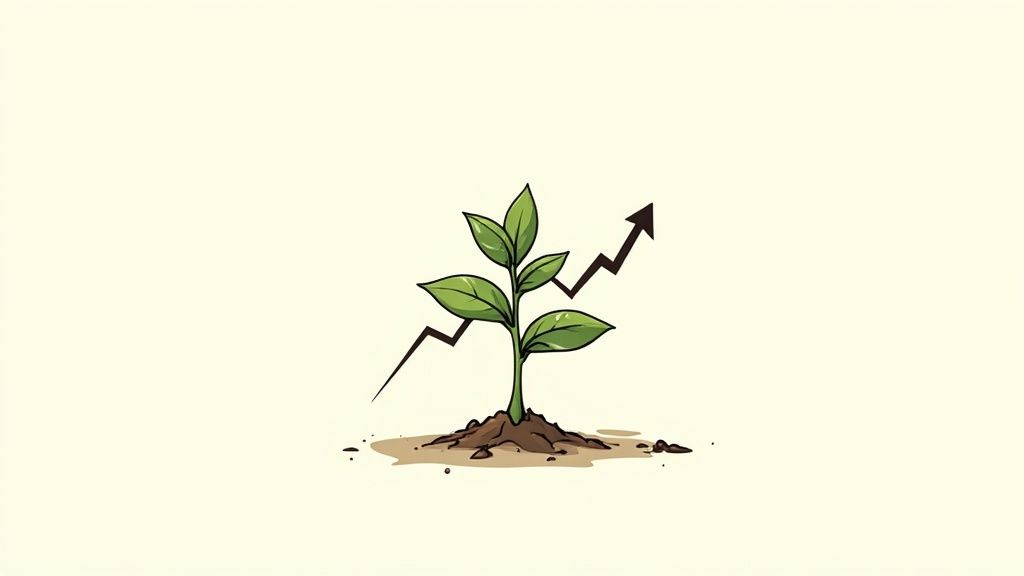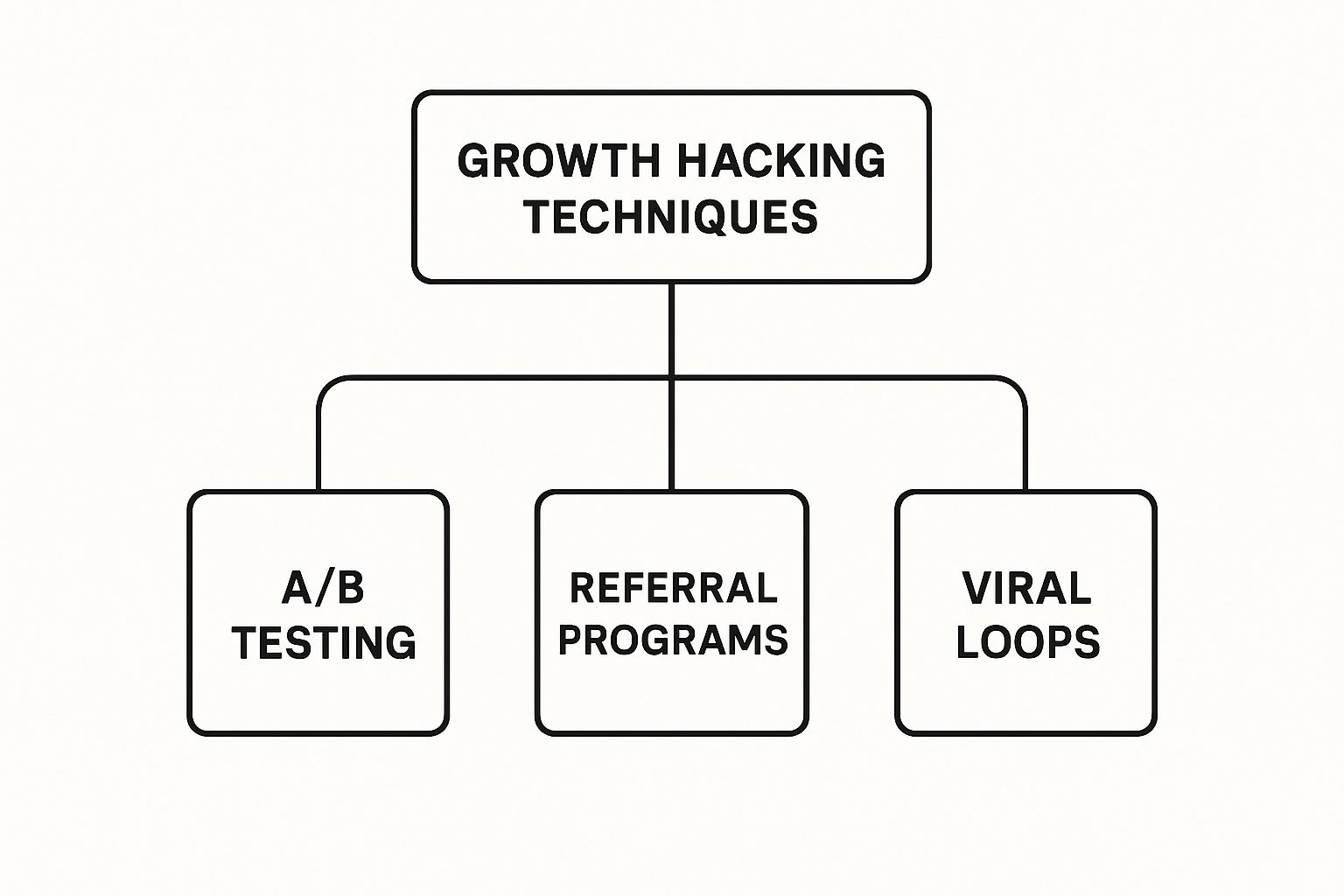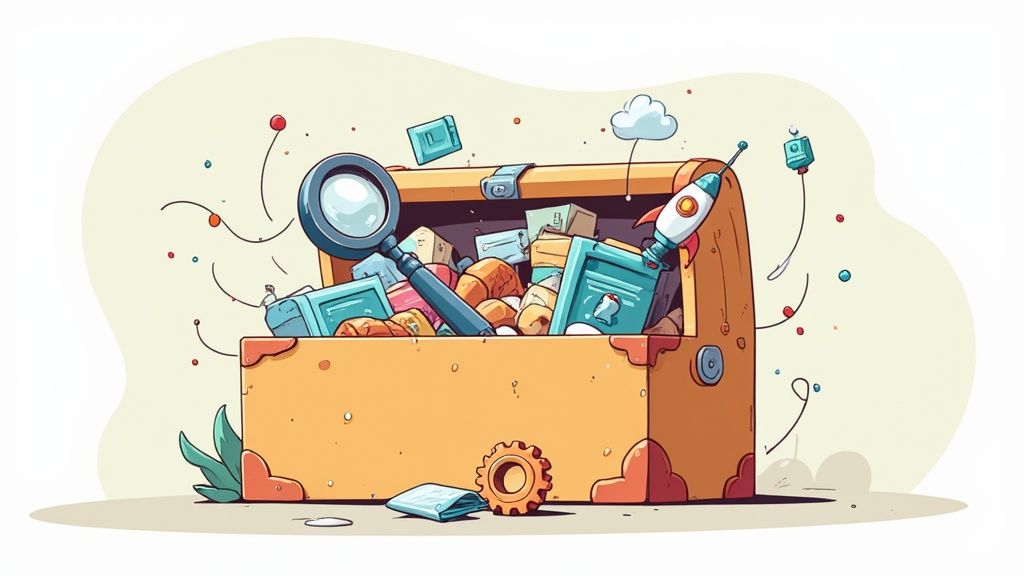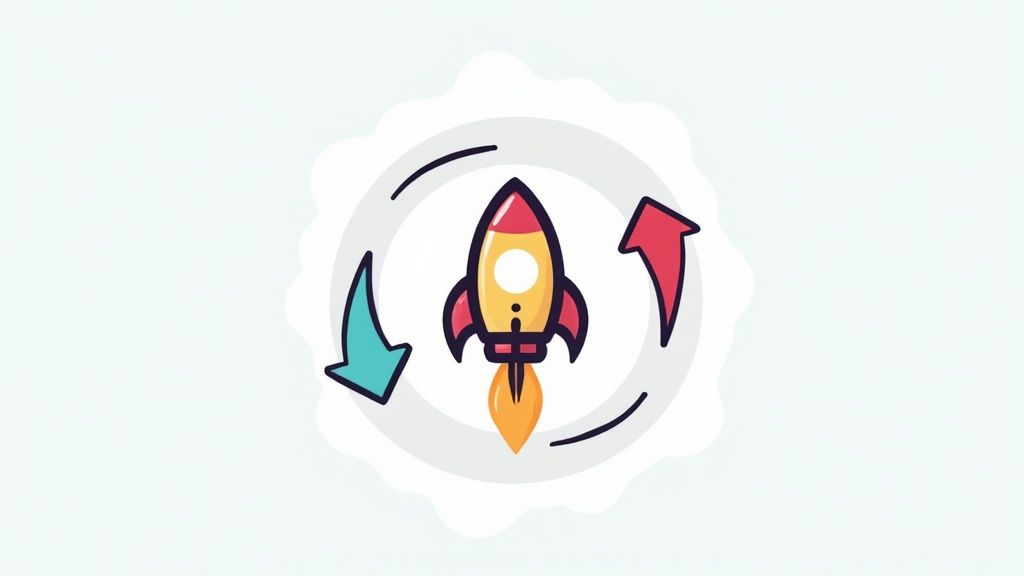
What Is Growth Hacking? The Ultimate Explainer
Published
So, what exactly is growth hacking? It's really about a specific mindset—a relentless and creative focus on one thing: growth. This isn't your standard marketing playbook. Instead, it’s a process of rapid, data-backed experiments across the entire business—from marketing and sales to product development—all designed to find the quickest, most efficient ways to grow.
Beyond Traditional Marketing
If you're thinking this sounds different from traditional marketing, you're right. A classic marketing approach often centers on building brand awareness and reaching customers through established channels, like big ad campaigns or content marketing. A growth hacker, however, sees the entire customer journey as their playground.
Think of it this way: a traditional marketer is like an architect. They carefully design a beautiful, structurally sound building meant to last for decades, following proven blueprints. A growth hacker is more like a scientist in a lab, constantly mixing potions and running small, controlled tests. They aren't afraid to try something wild, see what happens, and quickly toss out anything that doesn't produce results.
A Focus on Experimentation
At its heart, growth hacking is built on the scientific method. Instead of betting the farm on a massive, expensive campaign, a growth team operates in a loop of constant, small-scale testing.
Here’s what that looks like in practice:
- Form a hypothesis: "I bet changing our signup button from blue to green will boost conversions."
- Run a small-scale test: Use a simple A/B test to show the green button to half of the website visitors.
- Analyze the data: Check the numbers. Did the green button actually perform better?
- Iterate or scale: If the new button is a clear winner, roll it out to everyone. If not, it's back to the drawing board with a new idea.
Growth hacking isn't about finding one silver bullet. It's about building a system of continuous improvement—fueled by creativity and proven by data—where dozens of small wins add up to massive momentum.
This disciplined approach is why growth hacking has become so powerful in specific fields, like SaaS growth marketing, where rapid user acquisition and keeping customers happy are everything. The goal is always to uncover repeatable, scalable strategies that feel like a natural part of the product itself.
To really nail down the difference, it helps to see the two disciplines side-by-side.
Growth Hacking vs Traditional Marketing
This table highlights the fundamental differences in goals, methods, and focus between growth hacking and traditional marketing.
| Aspect | Growth Hacking | Traditional Marketing |
|---|---|---|
| Primary Goal | Scalable, measurable growth | Brand awareness and reach |
| Methodology | Rapid experimentation and iteration | Campaign-based and long-term planning |
| Focus Area | The entire customer funnel (AARRR) | Top of the funnel (acquisition) |
| Budgeting | Lean, low-cost, and ROI-driven | Often relies on larger, pre-approved budgets |
| Team Structure | Cross-functional (product, data, marketing) | Siloed marketing departments |
| Key Metrics | Conversion rates, LTV, churn, virality | Impressions, click-through rates, brand sentiment |
As you can see, the core philosophies are quite distinct. While traditional marketing builds a brand's foundation, growth hacking is designed to build momentum and scale it—fast.
The Story Behind Growth Hacking
To really get what growth hacking is all about, you have to picture Silicon Valley back in 2010. Startups were popping up everywhere, but they were running on fumes. They didn't have the deep pockets for Super Bowl ads or glossy magazine spreads. They needed to grow, and they needed to do it fast and cheap.
The old marketing rulebook just wasn't cutting it. These scrappy companies needed someone different at the helm—a person who was part creative marketer, part data analyst, and part product engineer, all rolled into one. Their one and only job? Growth.

The term itself was born out of this high-pressure environment. It was coined by Sean Ellis, a guy who had helped a bunch of startups like Dropbox hit massive scale. In a now-famous 2010 blog post, "Find a Growth Hacker for Your Startup," he laid out the blueprint for a new kind of marketing focused on relentless, data-backed experimentation. You can dive deeper into the history of growth hacking to see the full picture.
Pioneers of a New Framework
This wasn't just a cool theory; it was a battle-tested strategy that a few companies were already using to blow past their competition. They weren't just marketing their products; they were building growth right into the product itself.
Think about these classic examples:
- Dropbox's Referral Program: Instead of paying for ads, Dropbox gave users free extra storage for inviting friends. It was a brilliant move. Suddenly, every user became a salesperson, and sign-ups skyrocketed.
- Airbnb's Craigslist Integration: In the early days, Airbnb was struggling for visibility. They ingeniously built a simple tool that let hosts cross-post their listings on Craigslist with one click. This gave them direct access to a huge, built-in audience of people looking for places to stay, all for free.
- Hotmail's Email Signature: Hotmail pulled off one of the first viral growth hacks. They simply added a line to the bottom of every email sent: "P.S. Get your free email at Hotmail." Every email sent became a tiny, effective ad for their service.
These weren't just lucky marketing stunts. They were carefully designed experiments that used the product as the main engine for acquiring new customers.
What started as a survival tactic for broke startups soon caught on everywhere. Bigger, more established companies saw how powerful this mindset of rapid testing and iteration was. Growth hacking went from being a fringe idea to a core business discipline, fundamentally changing how we think about building and scaling companies today.
Adopting the Growth Hacking Mindset
To really get what growth hacking is all about, you have to look past the individual tactics and start thinking differently. It’s a complete mental shift from how traditional marketing works. Forget opinions and gut feelings; this is about a relentless, almost obsessive, focus on data. Every single decision becomes an experiment to be tested and measured—whether it’s something as small as changing the color of a button or as big as launching a new product feature.
This way of thinking demands a strange but powerful mix of creativity and cold, hard analysis. Traditional marketing is often about building brand awareness through established channels. A growth hacker, on the other hand, is always on the hunt for weird, unconventional, or completely overlooked opportunities to grow. This is where being deeply curious about why users do what they do becomes your greatest weapon.
At the heart of this mindset is a framework that you’ll hear about a lot: AARRR, better known as the "Pirate Metrics." It’s a simple but brilliant way to break down the entire customer journey into five clear, measurable stages.
Understanding the Pirate Metrics
Instead of seeing marketing as one big, monolithic activity, growth hackers view it as a funnel. Their job is to plug the leaks at every single step to keep users from dropping off and squeeze the most value out of the entire process. This systematic approach is fantastic for pinpointing exactly where your biggest growth levers are hidden.
Acquisition: How are people finding you in the first place? This is all about the channels bringing traffic to your doorstep, whether that’s through SEO, a clever social media campaign, or a viral loop you engineered.
Activation: Did they have a great first impression? This is about getting a new user to that "aha!" moment as fast as possible. You need them to immediately see and feel the value your product offers.
Retention: Are they sticking around? You can't grow a business if your customers are constantly leaving—that’s just a leaky bucket. This stage is dedicated to everything that keeps users engaged and coming back for more.
Referral: Do they love you enough to tell their friends? This is where growth really takes off and becomes explosive. Your happiest users can become your most powerful marketing team through simple word-of-mouth and referral programs.
Revenue: How do you actually make money? The final piece of the puzzle. This stage tracks the specific actions that generate cash, like a user upgrading to a paid plan or making their first purchase.
By breaking down the customer lifecycle like this, growth hackers can run hyper-focused experiments at each stage. The results aren't just additive; they're compounding. Think about it: a 5% improvement in both activation and retention can ultimately have a much bigger impact on your bottom line than a 10% boost in acquisition alone.
This hierarchy diagram gives you a great visual of some common techniques used to optimize each stage of the funnel.

As you can see, foundational tactics like A/B testing support more specific strategies like referral programs and viral loops. They all work together with one goal in mind: achieving scalable growth.
Once you truly adopt this mindset, it changes your entire approach to marketing and product development. It’s a whole new way of seeing the world.
Legendary Growth Hacking Examples
It’s one thing to talk about growth hacking in theory, but seeing it in action is what really makes the lightbulb go on. The most famous examples aren't just clever marketing ploys; they're masterclasses in understanding human behavior and weaving growth right into the fabric of the product. These stories prove that thinking differently can yield massive results, often without a massive budget.
Instead of just buying ads, these companies baked growth directly into the user experience. In doing so, they turned their own customers into a powerful, self-perpetuating marketing engine.

Dropbox: The Ultimate Referral Loop
One of the most classic, often-told stories of growth hacking comes from Dropbox. When the cloud storage company first started, it was jumping into a packed market where buying customers through ads was incredibly expensive. Their solution was so simple, it was brilliant.
Dropbox rolled out a two-sided referral program. Rather than just rewarding the person sending an invite, they gave 500MB of free bonus storage to both the existing user and the new friend who signed up. It was a subtle but critical shift that turned a selfish act into a mutually beneficial exchange.
The results were absolutely staggering:
- Sign-ups shot up by a permanent 60%.
- In just 15 months, Dropbox exploded from 100,000 users to 4 million.
- Referrals quickly became the single biggest driver of new customers.
This wasn't a marketing campaign; it was a product feature. Dropbox effectively deputized its entire user base into a motivated sales team, proving that the best growth happens when you empower the customers you already have.
Airbnb: Piggybacking on a Giant
In its scrappy early days, Airbnb faced the classic startup dilemma: a fantastic product with no one to sell it to. The founders knew their ideal customers were already on Craigslist, looking for alternatives to hotels. The trick was figuring out how to get in front of that huge, pre-built audience.
Their solution was a little controversial but undeniably ingenious. They built a simple, unofficial tool that let property owners cross-post their Airbnb listing to Craigslist with just one click. This move instantly put their listings in front of millions of eyeballs on a platform they didn't own, all without spending a penny.
It was the game-changer they needed. This hack provided the initial traction that allowed Airbnb to build momentum and eventually cultivate its own massive community.
Hotmail: The Original Viral Hack
Long before "going viral" was even a term, Hotmail pulled off one of the first and most effective growth hacks in internet history. As a free email service, they needed a way to spread the word without spending money.
The idea was simple: add a short, clickable signature to the bottom of every single email sent from their service: “P.S. Get your free email at Hotmail.”
Suddenly, every user became a walking advertisement. Each email they sent acted as a mini-billboard, delivered directly to someone in their trusted network. This created an exponential growth curve that rocketed Hotmail to 12 million users in only 18 months—a number that was completely mind-boggling at the time. For more recent examples of this kind of creative thinking, check out how Salesloop 'hacked' a LinkedIn job post.
The Tangible Business Impact of Growth Hacking
Beyond the clever tactics and viral startup stories, what does growth hacking actually do for a business's bottom line? It’s all about creating measurable, tangible improvements across the entire customer journey.
This isn't about throwing money at broad campaigns and just hoping for the best. Instead, growth hacking is about pinpointing the exact areas where small, smart changes can deliver the biggest punch. It’s a process of making incremental gains that stack up over time, creating massive compound growth.
A consulting firm, for example, put growth hacking techniques to work for a banking client and saw an immediate impact: an 8-10% increase in click-through rates and a 3-4% boost in conversions. These are the kinds of powerful, direct results that get noticed.
Driving Down Costs and Boosting Revenue
One of the first things businesses notice is a sharp drop in their Customer Acquisition Cost (CAC). By zeroing in on the most efficient channels and constantly tweaking the conversion funnel, companies can bring in new customers for a fraction of the usual cost. This alone sets it apart from traditional ad spending.
At the same time, there's a relentless focus on making the user experience better. This isn't just about aesthetics; it’s about boosting activation and keeping users around longer. When users are happy and engaged, their Lifetime Value (LTV) naturally increases.
This one-two punch of a lower CAC and a higher LTV is the secret sauce for sustainable, long-term revenue growth. It shares a lot of DNA with performance marketing, which is also built on measurable outcomes. You can dive deeper into that with our guide on what is performance marketing.
The true power of growth hacking isn't just about acquiring users cheaply; it's about building a system where each user becomes more valuable to the business over time, creating a profitable and scalable growth model.
To really get the most out of these wins, smart growth teams look to automate. Exploring different business process automation examples can show you how to scale successful experiments without getting bogged down by manual work. This frees up your team to hunt for the next big growth opportunity, creating a powerful cycle of continuous improvement.
Business Growth from Hacking Strategies
To put this into perspective, let's look at some real-world data showing the kinds of improvements businesses have achieved by implementing growth hacking strategies.
| Metric | Industry | Reported Improvement |
|---|---|---|
| Conversion Rate | E-commerce | Up to 50% increase |
| User Onboarding | SaaS | 30% lift in completion |
| Customer Acquisition Cost | Fintech | 60% reduction in CAC |
| Email Open Rate | Media | 25% higher open rates |
| Customer Retention | Mobile App | 40% increase in 90-day retention |
As the table shows, the impact isn't limited to a single industry or metric. The principles of rapid experimentation and data-backed decisions can unlock significant growth across the board, from how you acquire customers to how long you keep them.
How to Launch Your First Growth Experiment
So, you get the theory behind growth hacking. But how do you go from reading about it to actually doing it? It can feel like a massive jump, but here’s the secret: you don't need a huge budget or a special team to get started. You can kick off your first experiment with a simple, focused approach that gives you real data and teaches you a ton.
The first step is to resist the urge to fix everything at once. That's a surefire way to get overwhelmed and achieve nothing. Instead, pick just one metric you want to move. Zero in on a single, specific weak spot. Maybe it's the number of people who sign up for your newsletter from your blog, or perhaps it's the conversion rate from free trial to paid on your pricing page. This tight focus keeps the experiment manageable and makes the results easy to understand.

Brainstorm and Prioritize Your Ideas
Once you've got your target metric locked in, it's time to get creative. Start brainstorming hypotheses—basically, educated guesses about what changes could actually make a difference. Don't censor yourself here. Just let the ideas flow. Could a punchier headline work? A shorter sign-up form? What if you made the call-to-action button bright orange? Get it all down on paper.
Now you’ll have a list of ideas, and you need a smart way to decide where to start. A classic method used by growth teams everywhere is the ICE scoring model. It’s a simple framework for ranking your ideas based on three things:
- Impact: If this works, how big of a difference will it make to our metric?
- Confidence: How sure are we that this will actually work?
- Ease: How much time and effort will this take to build and launch?
Score each idea on a scale of 1 to 10 for each category. This little exercise quickly surfaces the low-hanging fruit—those high-impact, easy-to-do ideas you're most confident in. It’s a straightforward way to keep your efforts focused on what's most likely to pay off.
Design and Run a Low-Risk Test
With your best idea chosen, you’re ready to design a small, low-risk test. The A/B test is your best friend here. Let's say your hypothesis is that a more direct headline on a landing page will boost sign-ups. You'd simply show 50% of your visitors the original page (your "control") and the other 50% the new version with your punchier headline (the "variation").
After running the test for a while, it's time to look at the numbers. Did the new headline win? By how much? This is where knowing how to measure marketing effectiveness really comes into play. The beautiful thing is, it doesn't matter if you were right or wrong. Whether the experiment "succeeds" or "fails," you've just learned something real about your audience, and that insight will fuel your next move. This cycle—hypothesize, test, analyze, repeat—is the true engine of growth.
Growth Hacking FAQs: Your Questions Answered
Even after getting the hang of the basics, a few questions always seem to pop up. Let's tackle some of the most common ones to clear up any lingering confusion about growth hacking.
Is Growth Hacking Only for Startups?
Not at all. That’s a common misconception, probably because the term was born in the lean, scrappy world of startups. But those early days are long gone.
Today, companies of all sizes, including established Fortune 500 corporations, have embraced the growth hacking mindset. The core principles—rapid experimentation, data-driven decisions, and focusing on the entire customer funnel—are valuable for any business that wants to grow efficiently. It's about the methodology, not the company's age or headcount.
What’s the Difference Between a Growth Hacker and a Digital Marketer?
This is a great question, and the difference really comes down to focus and scope. A digital marketer typically zeroes in on the top of the funnel. Their world revolves around building brand awareness, driving traffic, and generating leads, usually through proven channels like SEO, PPC, or social media.
A growth hacker, on the other hand, looks at the bigger picture. They're responsible for growth across the entire customer journey, from the very first touchpoint all the way through to retention, revenue, and referrals. Their toolkit is a unique blend of marketing, product development, engineering, and data science, all aimed at one thing: running experiments to find scalable growth levers.
Think of it this way: a digital marketer's job is to bring people to the product. A growth hacker’s job is to make the product itself grow by optimizing every single step of the user experience.
Do I Need to Know How to Code to Be a Growth Hacker?
While coding skills can definitely give you an edge, they're not a deal-breaker. The most critical traits for anyone wondering what is growth hacking are relentless curiosity, a creative mind, and a deep-seated analytical approach.
Being able to dive into data, understand user psychology, and design a solid experiment is far more important than writing code. In fact, many of the most successful growth experts come from backgrounds in marketing, product management, or data analysis.
Ready to find your next role in this exciting field? Influencer Marketing Jobs curates the best opportunities in the industry. Find your perfect fit today.